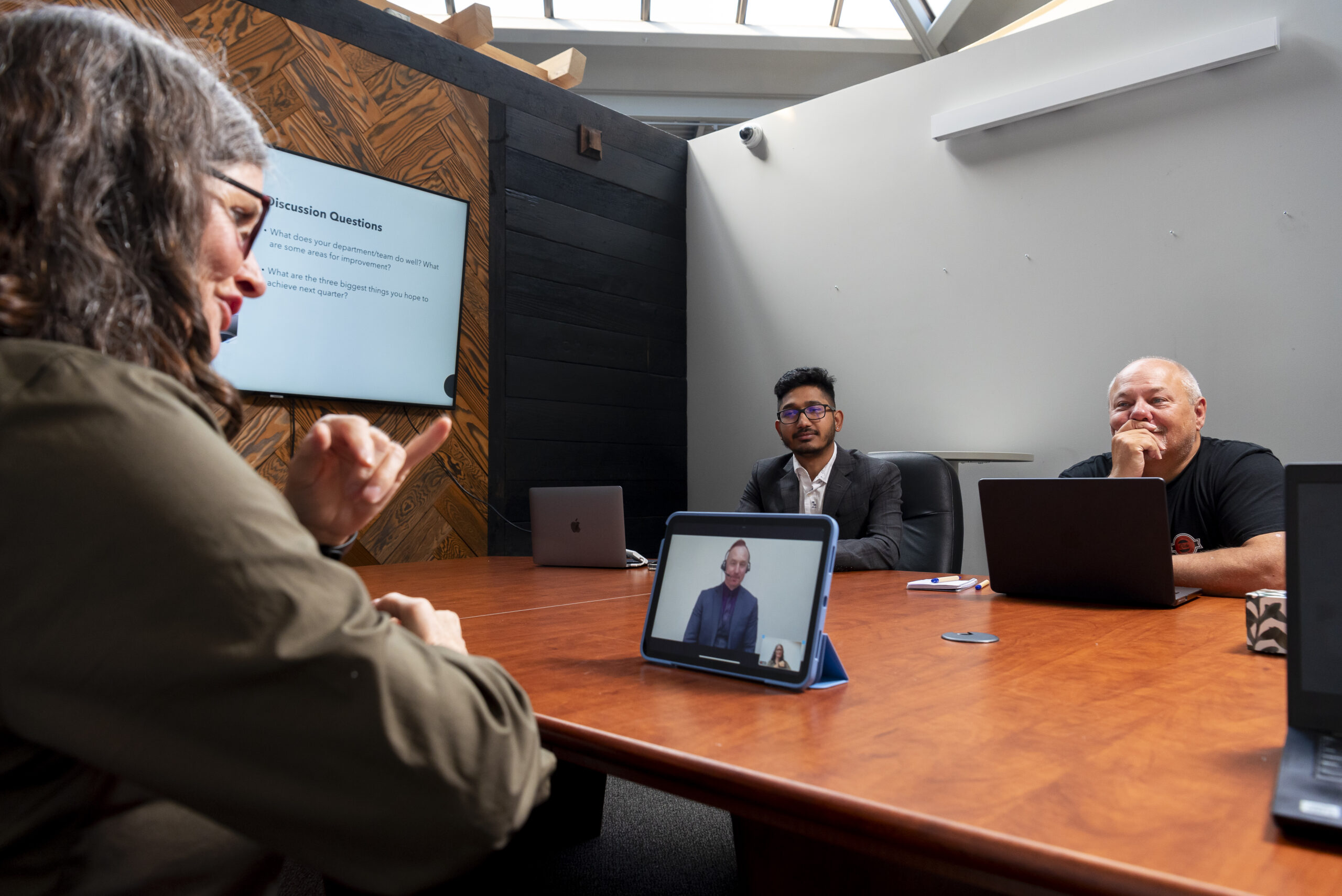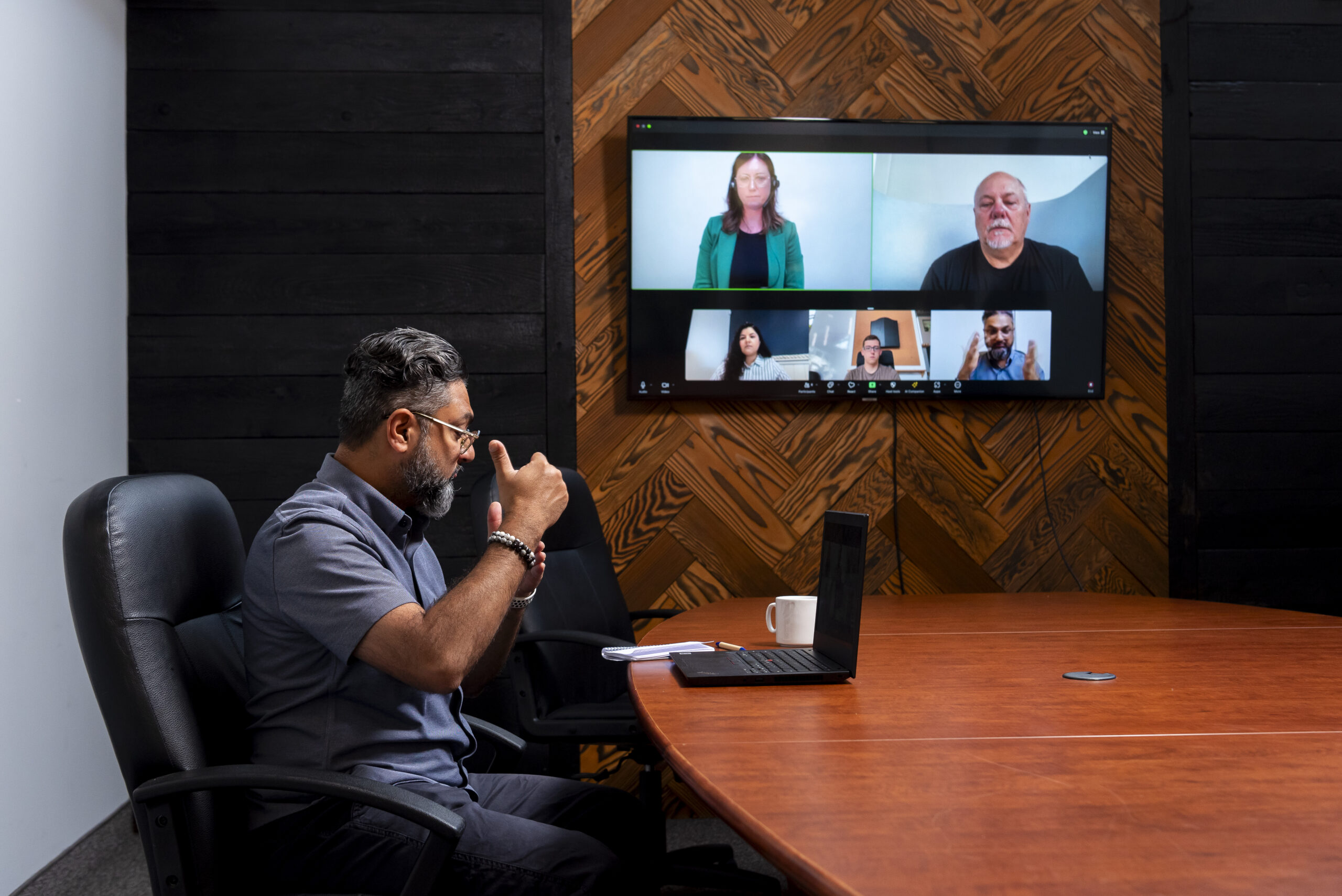Deaf individuals are often excluded from everyday workplace conversations, with interactions limited to waving “hi” in the hallway or voice-to-text updates from hearing colleagues. But that doesn’t have to be the case. With Video Remote Interpreting (VRI), you can fully integrate the Deaf community into your organization, enabling real-time, meaningful communication.
Unless you’re fluent in sign language, using an interpreter—whether in-person or over video—is the only way to truly connect with Deaf employees. Interpreters bridge language gaps to ensure all parties understand each other, meaning they support hearing employees just as much as Deaf employees.
So, What is Video Remote Interpreting (VRI)?
Video Remote Interpreting (VRI) is a paid interpreting service that uses video technology to connect people who use different languages with a virtual interpreter. In this case, we’re focusing on sign language interpreting which connects Deaf and hearing individuals with a sign language interpreter. Users can connect either in-person or virtually, but the interpreter is always remote. VRI eliminates communication barriers, allowing for real-time conversations between Deaf and hearing communities.
What Kinds of VRI Services Are Available?
There are two types of VRI services: VRI by Appointment and VRI On-Demand.
VRI by Appointment: Best for longer, pre-planned meetings where an interpreter is booked in advance.
Examples: Planned training sessions, regular staff meetings, webinars and other online events.

VRI On-Demand: Ideal for shorter, spontaneous or incidental interactions. No appointment needed.
Examples: Impromptu meetings, urgent or time-sensitive situations, emergencies and other unplanned conversations with Deaf employees.

How Does VRI Work?
VRI works differently depending on the service. Here’s an example of how VRI On-Demand works:
Imagine this: A Deaf employee stops by their supervisor’s desk to ask a question:
- The Deaf employee brings out a tablet, using it to video call a sign language interpreter.
- The Deaf employee communicates using their first language—American Sign Language (ASL).
- The interpreter relays what the Deaf employee is signing to their supervisor in English.
- The supervisor answers the Deaf employee’s question via the interpreter.
- The process repeats!
All they needed for this interaction was a smart device with a camera and high-speed internet—it’s that simple. Need a visual example? Watch this video demonstrating how a Deaf travel agent uses the service to communicate with a customer.
If that same employee were to use VRI by Appointment, they’d schedule an interpreter in advance, giving them all the context and materials necessary to prepare for the meeting. At the meeting time, the interpreter would join via a video conferencing platform, such as Zoom or Microsoft Teams.

How Does VRI Benefit the Deaf Community?
ASL and LSQ are the primary languages of Deaf people in Canada, as recognized by the Accessible Canada Act. English and French are often second—or even third or fourth languages for Deaf individuals. VRI removes language barriers that prevent the Deaf and signing community from accessing essential services—and opportunities.
Stereotypes and misconceptions about the Deaf community can keep qualified Deaf candidates from being considered for job opportunities. Even if hired, they might be overlooked for promotions, despite possessing the same skills as their hearing colleagues. VRI helps even the playing field, empowering Deaf employees to participate and contribute to every workplace conversation.
I was initially resistant because I was used to having an in-person interpreter in the room. But once I used VRI-On Demand, it was amazing—it transformed my life. I’m much happier, and I wonder how I functioned at work without it. I’m so grateful that my employer supported me and put VRI-On Demand in place.
– Carrie Downey, Lead Operator in the Assay Department at the Royal Canadian Mint
We interviewed Carrie Downey, a Deaf employee at the Royal Canadian Mint who works as the Lead Operator in the Assay Department. In her role, she is responsible for ensuring that the gold and silver sourced from mines are sufficient for coin production. Leading a team of five, she distributes daily tasks focused on the analysis of these metals. Carrie shared how the implementation of VRI On-Demand in 2020 impacted her employee experience:
“I was initially resistant because I was used to having an in-person interpreter in the room. But once I used VRI-On Demand, it was amazing—it transformed my life. I’m much happier, and I wonder how I functioned at work without it. I’m so grateful that my employer supported me and put VRI-On Demand in place.”
Carrie’s manager, Charles Daoust, argues that the service is necessary to ensure Deaf employees have access to the same information shared with the team. Written communication doesn’t have the same impact as VRI On-Demand.
“It really helps being able to build a connection and have meaningful conversations, which would otherwise be more difficult, or lost in translation over other more traditional means [of communication.]” says Charles Daoust, Chief Assayer & Manager of Assay Services at the Royal Canadian Mint.
4 Ways Video Remote Interpreting (VRI) Impacts HR
VRI Supports and Engages Deaf Employees
85% of HR leaders say employee experience is the most valuable HR capability. HR plays a critical role in developing employee engagement strategies and selecting the tools to implement them. For HR leaders looking to engage Deaf employees, VRI is an essential solution.
People Element’s 2024 Employee Engagement Report highlights the top three drivers of employee engagement: feeling heard and valued, having opportunities for growth, and trust in leadership. VRI plays a key role in improving these drivers for Deaf employees. By enabling them to actively share their ideas and opinions, VRI helps Deaf employees feel valued.
Using VRI leads to higher levels of employee engagement, which directly impacts productivity, loyalty and retention. As an HR professional, being able to support and empower Deaf employees is both impactful and fulfilling.
– Jocelyn Mark, Asign HR Director
It also supports their professional growth by ensuring clear communication during performance reviews, allowing them to receive the feedback they need to excel in their roles. Furthermore, implementing VRI demonstrates to Deaf employees that their employers are invested in their success, fostering trust and confidence in leadership.
Jocelyn Mark, Asign HR Director and Excellence Awardee for the 2024 HR Rising Star of the Year, shares her experience with VRI: “Using VRI leads to higher levels of employee engagement, which directly impacts productivity, loyalty and retention. As an HR professional, being able to support and empower Deaf employees is both impactful and fulfilling.”
VRI Diversifies your Talent Pool
“A person who has a disability will bring increased innovation and problem-solving skills, and the perspective of lived experience to a company”
– Jeannette Campbell, CEO of the Ontario Disability Employment Network.
Deaf individuals overcome obstacles daily while navigating a world designed for hearing people. This resilience and adaptability make them valuable employees who embrace challenges and bring fresh problem-solving skills to your team. Their unique perspectives can also help your company create more inclusive products, services and policies that better serve Deaf and hard of hearing customers.
Employing Deaf individuals begins with accessible hiring practices. For instance, use plain, inclusive language in job postings to attract people with disabilities, accept job applications in ASL, and ensure the interview process is fully accommodating. To provide equal opportunities, Deaf candidates need equal access to communication—which is possible through VRI.
VRI Supports a Culture of Inclusion
VRI helps organizations build a more welcoming and accessible work environment. By including Deaf employees in online events and meetings, you’re showing your team that you value everyone’s contributions and perspectives. Committing to accessibility will create a ripple effect, shaping your company’s overall approach to equity, diversity and inclusion, and encouraging other employees to embrace these values as well.

VRI Helps Your Organization Meet Legal Requirements
Accommodating your employees is not just “the right thing to do”—it’s the law. The Canadian Human Rights Act mandates that organizations under federal jurisdiction ensure equal treatment for all employees. The duty to accommodate requires organizations to prevent discrimination by making adjustments to work environments or duties. By integrating VRI, organizations can offer accessible communication solutions and fulfill their legal obligations, reducing the risk of discrimination claims.
Examples of Video Remote Interpreting (VRI) for Deaf Employees in a Workplace Setting
When to use VRI by Appointment:
- Webinars and Virtual Conferences: So Deaf individuals can participate as attendees, panelists, or presenters.
- Interviews: So Deaf candidates can respond to questions in their first language, ensuring a fair hiring process.
- Onboarding & Training Sessions: So Deaf employees integrate smoothly into their new roles and receive ongoing opportunities for professional growth.
- Scheduled Internal Staff Meetings: VRI by Appointment is ideal for longer meetings or those planned well in advance (e.g., performance reviews or 2-hour weekly project meetings).
- Scheduled Customer Meetings: Use VRI by Appointment for longer, pre-arranged client interactions so that Deaf employees can communicate effectively and build strong client relationships.
When to use VRI On-Demand:
- Internal Staff Meetings: Use VRI On-Demand for short or unplanned meetings (e.g., emergency meetings or daily standups) to include Deaf employees in conversations they are often left out of.
- Customer Meetings: If client visits or calls are unpredictable, VRI On-Demand ensures Deaf employees can communicate with customers whenever needed.
- Social Settings: Use VRI On-Demand during breaks and team outings to help Deaf and hearing colleagues connect and get to know each other. Without it, Deaf employees would need to schedule an interpreter just for a casual chat—something many hearing employees take for granted.
- Job Fairs, Networking Sessions: To promote your job opportunities and engage Deaf candidates as they approach, rather than hiring an interpreter for the entire event.
The Benefits of VRI
Improved Communication with Staff
Communicating in sign language is essential for accuracy and understanding. Carrie Downey, Lead Operator in the Assay Department at the Royal Canadian Mint, uses VRI On-Demand at the beginning of every shift to meet with her team, discuss objectives, and address challenges.
Clear communication is especially necessary for critical situations. Carrie recalls how VRI On-Demand helped her communicate effectively with her supervisor when dealing with a personal matter.
“After a bad fall, there was a possibility I needed extensive surgery. With VRI On-Demand, I clearly explained the situation to my supervisor, and we discussed how employees could be trained for my absence. In the past, we would’ve had to write back and forth, but VRI On-Demand allowed for seamless communication, where my supervisor could show their understanding and empathy.”
Eliminates Travel Costs and Potential Delays
While in-person interpreting is ideal for large, in-person meetings like town halls and legal trials, many interactions can be handled via VRI. This saves organizations from covering travel expenses for on-site interpreters.
On-Demand Interpreter Access Without the Cost of Employing an Interpreter Full-Time
You can’t always predict or plan interactions—some are spontaneous or incidental. Regardless, these conversations are crucial to creating a unified culture within your organization. Asign offers VRI On-Demand so that organizations can access interpreters only when needed, instead of paying for a full-time interpreter. VRI On-Demand is a cost-effective solution, providing access to an interpreter within minutes. That way, you’re always ready to connect with Deaf employees.
Best Practices for Implementing VRI in the Workplace
Assessing the Need for VRI in Your Organization
To assess whether VRI will benefit your organization, reflect on the following:
- Approximately 5-10% of Canadians are Deaf or hard of hearing, according to Statistics Canada and the Canadian Association of the Deaf. Are you missing out on potential clients?
- You likely already have Deaf or signing customers, even if you don’t realize it. By promoting ASL and LSQ interpreting services in your business and on social media, you’ll attract new customers and encourage existing ones to engage and ask questions while shopping, using your services or seeking information.
- Do you have Deaf employees, or are you aiming to become a more inclusive employer?
Consider the size and composition of your organization. If you have a Deaf employee or serve the public, implementing VRI can help you build and strengthen relationships. Book a consultation with our team, and we’ll guide you through the process.
Choosing the Right VRI Service Provider
Your service provider should meet the following criteria:
- Professional: To ensure client confidentiality, interpreters must have security clearances, ranging from Reliability to Top Secret.
- Canadian Expertise: Interpreters should be well-versed in the different regional and provincial dialects of American Sign Language (ASL) and langue des signes québécoises (LSQ). They also need to understand the Canadian landscape—its government, politics, and culture—to provide accurate interpretations.
- High-Quality Service: Providers must be able to tailor their services to meet your organization’s needs, using industry-specific terminology. Look for certifications such as International Standards Organization (ISO) and Canadian Language Industry Association (CLIA) to ensure consistent quality.
- Community-Focused: Providers should be recognized and trusted within the Deaf community. Consider consulting with your Deaf employees or customers before selecting a service provider.
Training HR staff and employees on using VRI effectively
Every employee, whether hearing or Deaf, should feel empowered to use VRI. As an HR professional, it’s your responsibility to make that happen. Your employees should receive training on how to use VRI and how to work with interpreters. Below are just a few tips—there is much more information available, so consider these a starting point.
Using VRI by Appointment: Whenever possible, request interpreting services 2-3 weeks in advance. For larger events, such as week-long conferences, make these requests even sooner—ideally two months in advance. Provide as much information as you can about your meeting or event, and our booking specialists will find the right interpreter(s) for the job. Once the services are confirmed, share any preparation materials—such as the agenda, notes, slides, and pre-recorded content—so the interpreter(s) can familiarize themselves with the subject matter and specific terminology.
Using VRI On-Demand: Ensure every Deaf employee has access to a VRI On-Demand account and understands the steps required to video call an interpreter. Once they’ve been trained on the application, they’ll be able to use it for incidental conversations throughout their day-to-day.
Working with interpreters: Communicating through an interpreter might not feel natural to everyone at first. If you’re new to the experience, here are some of our top tips on working with interpreters. Remember: The interpreter’s job is to facilitate communication. It’s their responsibility to interpret everything, including side comments and incidental conversations.
How We Can Help
At Asign, we specialize in high-quality sign language interpreting services. With over 25 years of experience, we’re committed to connecting people, ideas and communities through sign language. Our Video Remote Interpreting (VRI) services are available by appointment and on-demand, allowing clients to connect with professional interpreters anytime, anywhere. Let’s create a more connected, accessible workplace—together!
Discover how our VRI services can transform your organizationWhen I talk to Deaf employees at other organizations they always say, ‘You’re so lucky to have VRI On-Demand in your workplace. I wish I had the same.’
– Carrie Downey
In Conclusion
When asked what advice she would you give to HR professionals considering VRI for their organizations, Carrie said the following:
“Every Deaf employee should have VRI On-Demand. We need access—it improves our efficiency, productivity and overall well-being. When I talk to Deaf employees at other organizations they always say, ‘You’re so lucky to have VRI On-Demand in your workplace. I wish I had the same.’
I want every employer to know that VRI On-Demand is beneficial for both their employees and their business—it’s a win-win.”
– Carrie Downey, Lead Operator in the Assay Department at the Royal Canadian Mint.
Special Acknowledgment: Thank you to our Asign team members, Jocelyn Mark and Heather Marsden, as well as Royal Canadian Mint employee, Carrie Downey, for sharing your knowledge and experiences with us. Your contributions are greatly appreciated!
Related Articles
Accessibility, Success Stories | Nov 28, 2025
Beyond Access: How On-Demand Interpreting Helped Unlock a Team Member’s Full Potential
Accessibility | Nov 19, 2024
Building the Business Case for Accessibility in the Canadian Banking Sector
VRI | Nov 28, 2022



